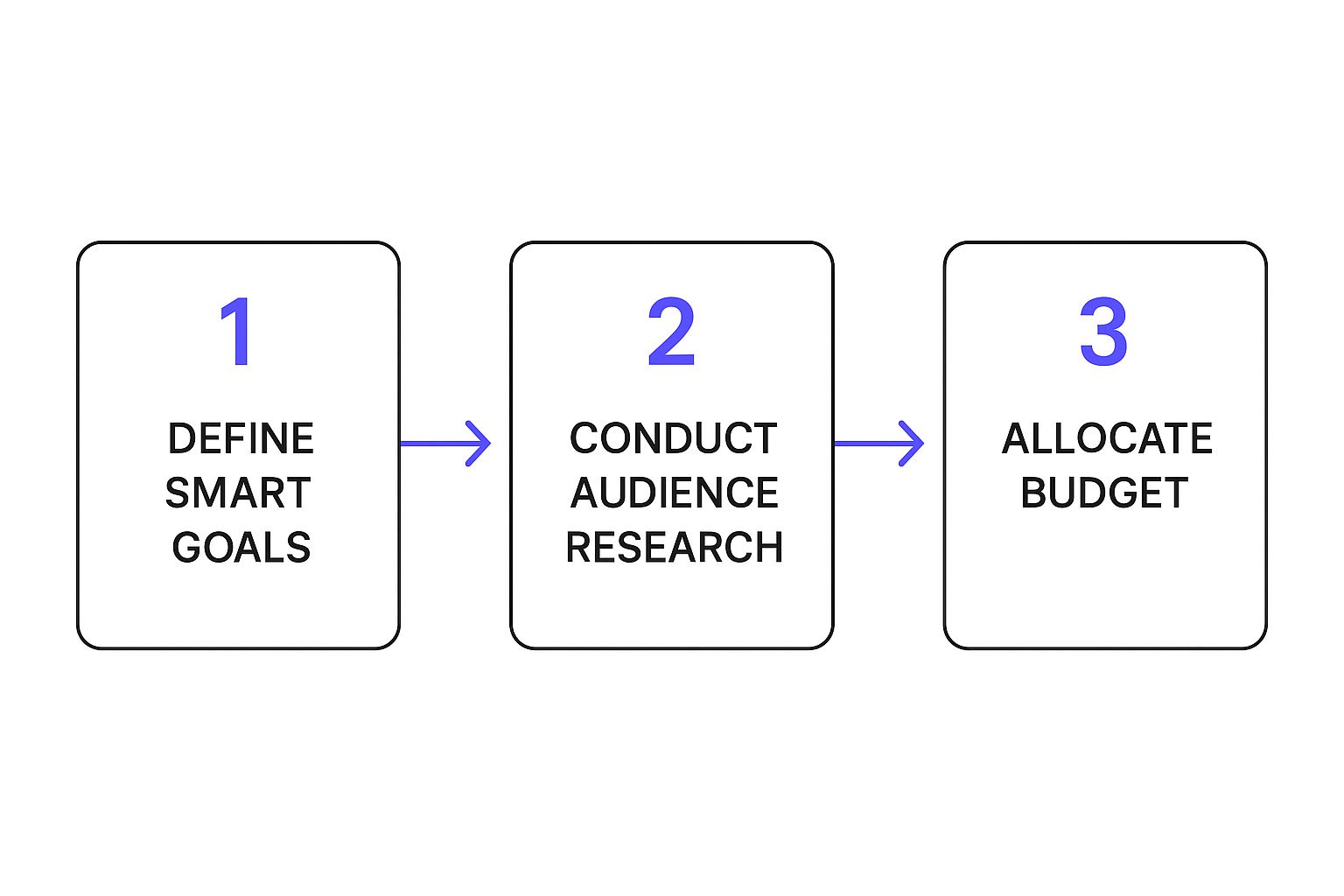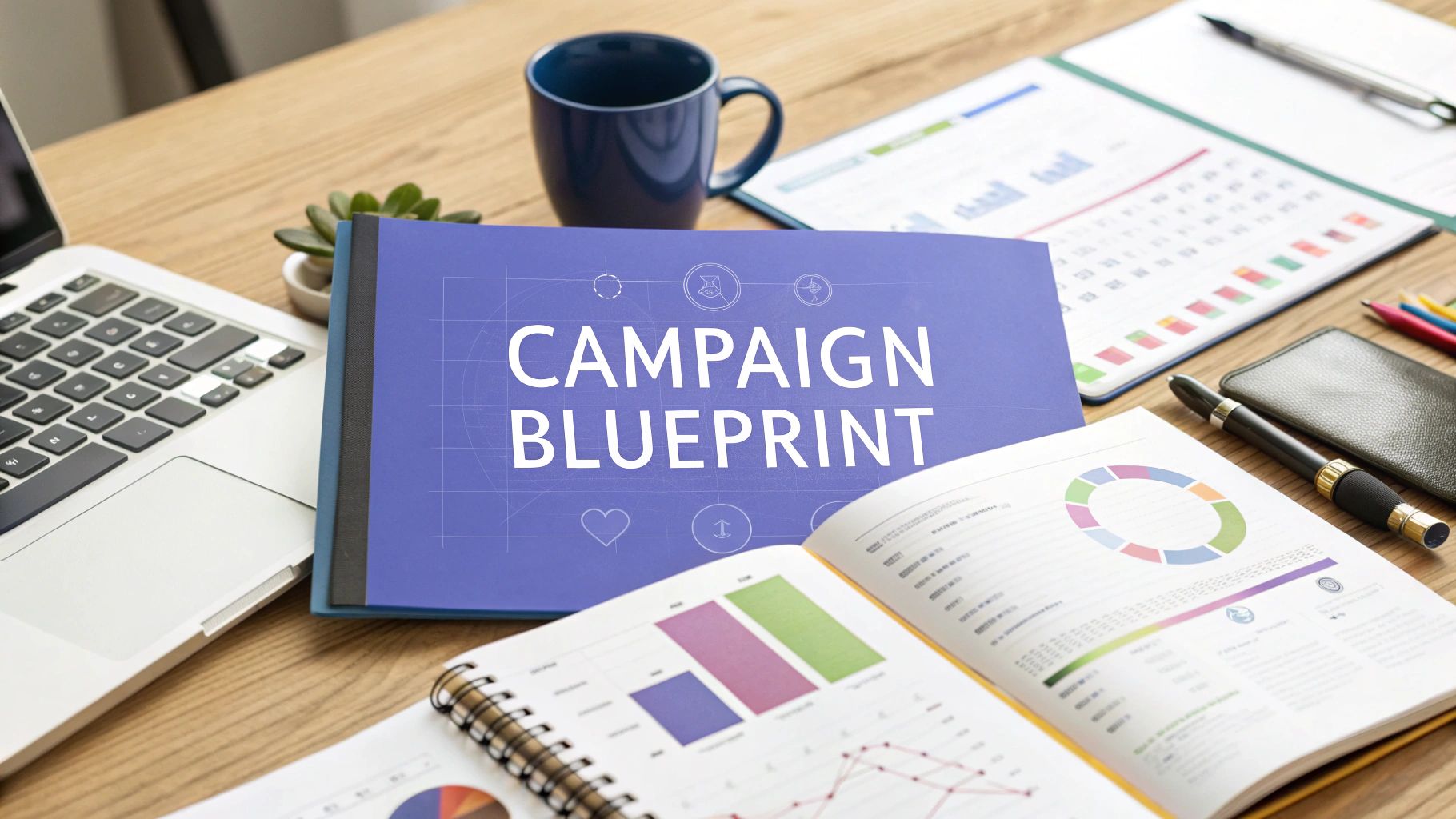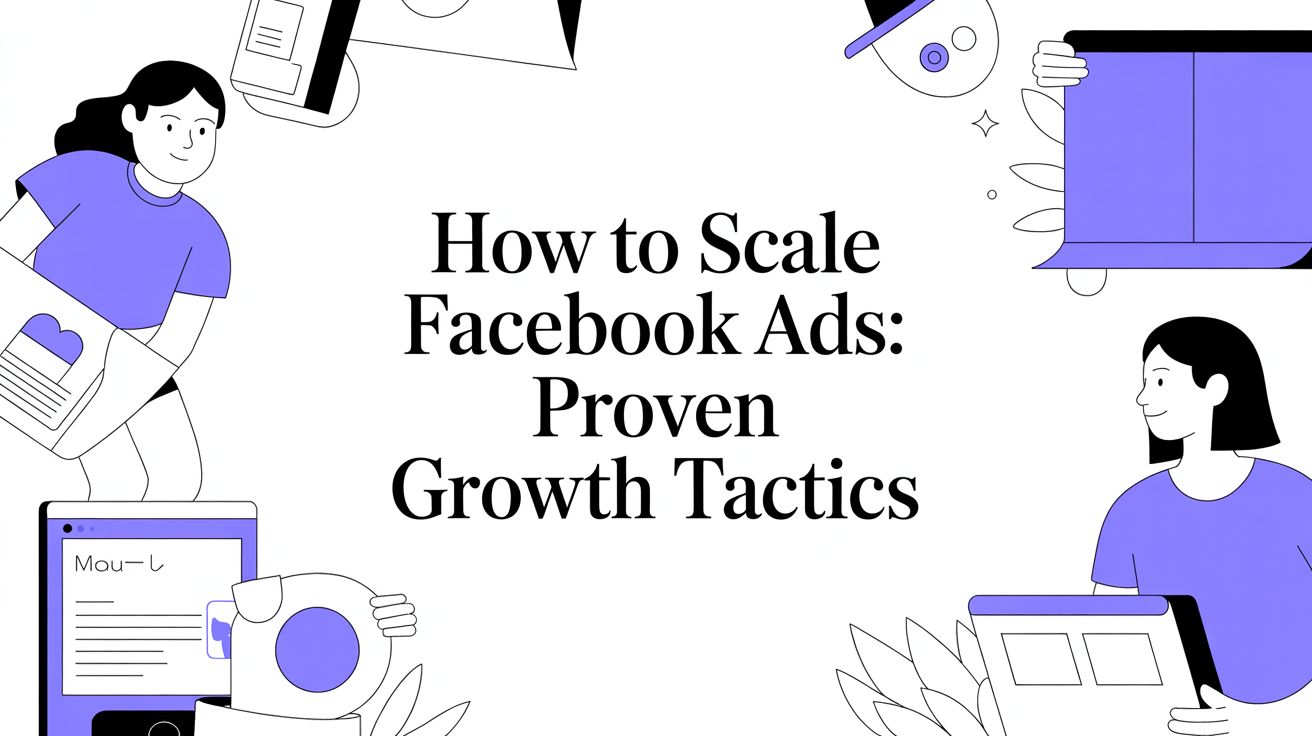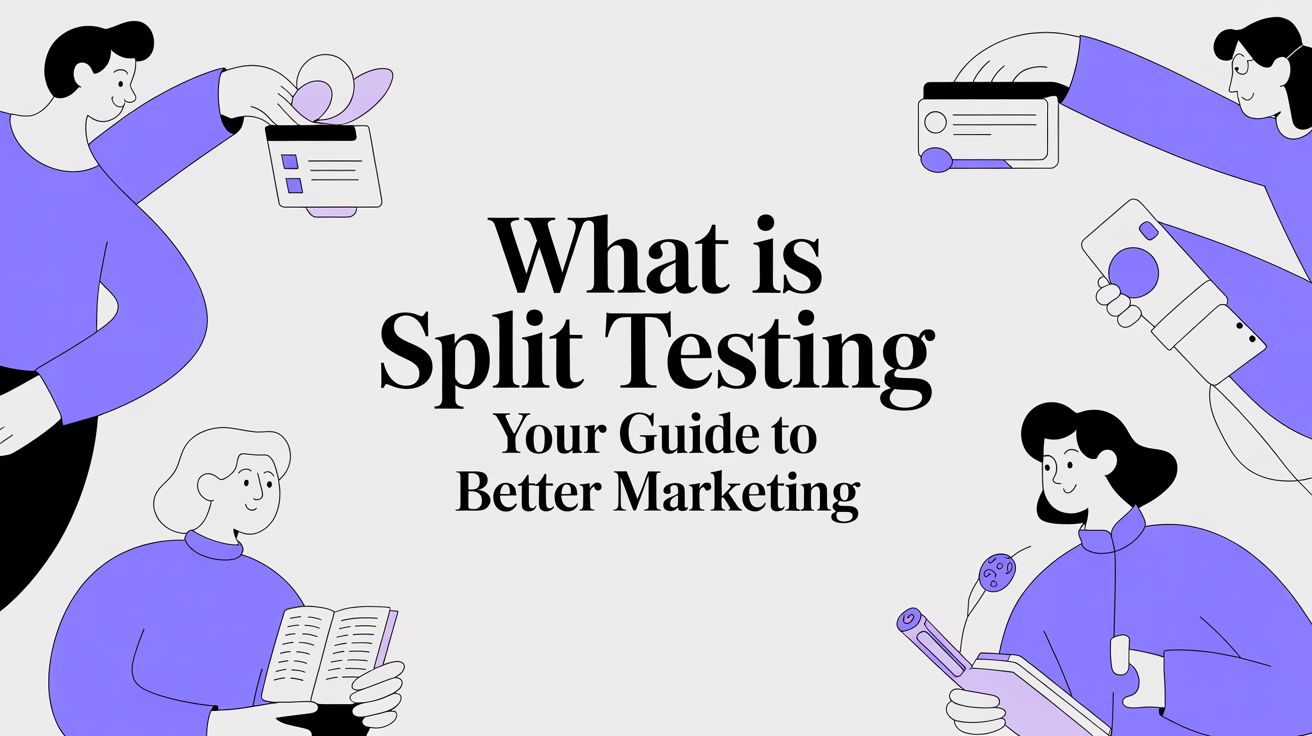A solid marketing campaign planning template isn't just a document; it's the strategic framework that separates wildly successful campaigns from costly flops. Think of it as the blueprint that turns a brilliant idea into measurable, repeatable results, making sure every dollar and hour you invest actually moves the needle. It’s what stops the guesswork and gets your entire team pulling in the same direction.
Why a Campaign Template Is Your Secret Weapon

Let's be real—marketing without a plan is just a very expensive guessing game. A structured template isn't just another bureaucratic hoop to jump through. It's the strategic backbone that prevents budget blowouts, mixed messages, and blown deadlines before they even have a chance to happen. It forces you and your team to think through every critical piece of the puzzle, from the big-picture goals down to the smallest execution details.
Picture this: you're launching a new product. Without a shared plan, your social media team might be chasing engagement, while your email team is trying to drive webinar sign-ups, and the sales team just wants immediate leads. The result? A disjointed, confusing customer experience where no one is sure what success even looks like. A good template eliminates that chaos by creating a single source of truth that aligns everyone.
Moving From Chaos to Clarity
A well-designed template is all about turning abstract goals into concrete, actionable steps. It provides a clear roadmap that answers the most important questions: Who are we trying to reach? What is our core message? Where will we deliver that message? And, critically, how will we know if we've succeeded? This clarity is the secret to building a repeatable process for winning, not just getting lucky once in a while.
The data backs this up. Marketers who document their strategy are a staggering 538% more likely to report success than those who don't. That number alone shows just how much planning impacts performance. You can dig deeper into the power of structured planning over at Project Skills Mentor.
A campaign template doesn't just organize your thoughts; it professionalizes your entire marketing operation. It transforms your team from reactive order-takers to proactive strategists.
This single document becomes the command center for your campaign. It ensures your content creators, ad specialists, designers, and sales reps are all working from the same playbook, bridging that all-too-common gap between a great idea and a great outcome.
From Chaos to Clarity: The Impact of a Template
Every marketer has been there—dealing with misaligned teams, fuzzy goals, or campaigns that just don't land. A template is your best defense against these chronic headaches.
Here’s a quick look at common marketing headaches and how a structured campaign template solves them.
| Common Challenge | Solution with a Template |
|---|---|
| Vague Objectives | Forces you to define specific, measurable SMART goals from the start. |
| Budget Mismanagement | Requires a detailed budget breakdown for each channel and activity, preventing overspending. |
| Inconsistent Messaging | Centralizes your core message, value props, and tone of voice for everyone to see. |
| Missed Deadlines | Establishes a clear timeline with key milestones and who is responsible for what. |
| Poor ROI Tracking | Mandates the selection of Key Performance Indicators (KPIs) from day one, so you know what to measure. |
By addressing these issues before the campaign even kicks off, the template sets the stage for a much smoother, more effective execution. It’s proactive, not reactive.
Building Your Template From the Ground Up
Alright, let's get our hands dirty and start building this template from the ground up. This isn't just a box-ticking exercise; it’s about making the strategic decisions that will steer every single thing you do from here on out. A powerful campaign is always built on a foundation of absolute clarity.
Everything—and I mean everything—starts with why you're even doing this. Before a single social media post is drafted or one line of ad copy is written, you have to define what success actually looks like in real, measurable terms. Vague goals like "increase brand awareness" are pretty much useless. You need to get specific with SMART goals: Specific, Measurable, Achievable, Relevant, and Time-bound.
Pinpoint Your Campaign Goals
A truly effective goal gives your team a finish line to sprint towards. It takes all the guesswork out of the equation and gives you a clear target.
Think about the difference here:
- A bad goal: "Get more leads."
- A SMART goal: "Generate 500 marketing qualified leads (MQLs) from our new ebook download campaign within Q3, with a target cost per lead of under $25."
See the difference? That level of detail is non-negotiable. It tells your team exactly what to measure, what the budget guardrails are, and when the clock runs out. Your template needs a dedicated spot for one to three of these primary SMART goals to anchor the entire campaign.
Craft Detailed Buyer Personas
Once you know what you're aiming for, you have to figure out who you're talking to. A generic, surface-level understanding of your audience just won't cut it. You need to build out detailed buyer personas that feel like real people, because that’s exactly who you’re trying to connect with.
A strong persona goes way beyond basic demographics. It gets into the psychographics—what motivates them, what are their biggest challenges, and what are the daily frustrations that keep them up at night?
Your message will only hit home if it speaks directly to a specific person's problems and aspirations. Crafting a persona forces you to step out of your own head and into your customer's shoes.
For example, instead of targeting "small business owners," you create a persona like "Startup Sarah." She's a 32-year-old founder of a B2B SaaS company, completely overwhelmed by her marketing to-do list, and is desperately looking for tools that save her time and deliver a clear ROI. From this point on, every piece of content you create should be written specifically for Sarah.
This is the logical flow I'm talking about—from goals to audience to the resources you'll need.

As you can see, each step builds on the last. This ensures your budget is spent reaching the right people with a message that's directly tied to your objectives.
Outline Your Core Message and USP
Now that your goals are set and your audience is crystal clear, you can finally craft your core message. What's the one single thing you want "Startup Sarah" to take away from this campaign? This isn't the place for a laundry list of features; it's the story you're telling.
Your template absolutely needs a section for your Unique Selling Proposition (USP). This is just a clear, punchy statement that explains how your offer is different from—and better than—anything else out there.
In your template's messaging section, I'd suggest including:
- The Core Message: A one-sentence summary of the campaign's big idea.
- The USP: What makes your offer the only real choice? (e.g., "The only AI video tool that creates 10 UGC-style ads in 5 minutes.")
- Key Talking Points: Three to five bullet points that back up your core message and USP.
This need for consistency and predictability is exactly what drove the evolution of the modern marketing template. Today, these documents are much more dynamic, often including built-in formulas to estimate impressions or track conversion rates. If you want to dive deeper into how these templates have advanced, you can find some great insights on Smartsheet.com.
Mapping Your Channels, Budget, and Timeline

An idea without a budget or a timeline is really just a dream. This is where your marketing plan gets real—where strategy meets the constraints of money and time. You'll be figuring out where to put your dollars and how to schedule everything to get the biggest bang for your buck.
It all starts with picking the right channels, and that decision should hang on one simple question: Where does my audience actually spend their time? It's so easy to get caught up in the latest shiny platform, but if your ideal customer isn't scrolling through TikTok, you're just throwing money away. A SaaS company selling to tech founders, for example, is going to have a much better time on LinkedIn than anywhere else.
Getting Smart With Your Budget
Once you know where you're going to be, it's time to decide how much to spend. This doesn't need to be some complicated financial model. The easiest place to start is often your own history. Look at past campaigns. Which channels gave you the best Cost Per Lead (CPL) or Return on Ad Spend (ROAS)?
If you're flying blind without any past data, you can take a more experimental approach.
- Test the Waters: Earmark a small part of your budget, maybe 10-20%, to run some initial tests across your chosen channels.
- Check the Score: After a couple of weeks, dive into the data. What's working? What's not?
- Double Down: Funnel the rest of your budget into the channels that are clearly winning based on your main KPIs.
A solid grasp of what is multichannel marketing is crucial here. The goal isn't just to be everywhere; it's to show up consistently and cohesively on the handful of platforms that matter most to your audience. That’s how you make every dollar count.
Building a Timeline That Actually Works
With your channels and budget locked in, the final piece of the puzzle is the timeline. A great campaign timeline isn't just a start and end date. It's a detailed project plan built around clear, achievable milestones. This is what keeps your team on the same page and helps you avoid that last-minute scramble to launch.
A timeline without milestones is just a wish list. Milestones are the checkpoints that turn your plan into a predictable, manageable process, ensuring every component is ready on schedule.
Your timeline should map out every single key activity. This creates total visibility for the team and makes it clear who is responsible for what.
Let's imagine you're planning a product launch. A milestone-based timeline might look something like this:
- Weeks 1-2: Nail down the messaging, write all the ad copy, and get the visuals designed.
- Week 3: Build out the landing pages and make sure all the tracking and analytics are set up correctly.
- Week 4: Get all social media posts scheduled and the ad campaigns built and ready to go live.
- Week 5: Launch Day! Now the daily monitoring of performance begins.
- Weeks 6-8: Start A/B testing different ad creatives and shift your budget based on what's performing best.
Laying things out this way is also a lifesaver for managing https://sprello.ai/blog/multi-platform-content-delivery. You can see exactly when you need different versions of your assets for each channel, which helps you avoid bottlenecks and keeps the campaign running smoothly from start to finish.
Defining Metrics That Actually Matter
If you can't measure it, you can't improve it. It's an old cliché, but in marketing, it's the absolute truth. The problem is, we're drowning in data. It’s far too easy to get caught up tracking "vanity metrics"—those flashy numbers that look great in a report but don't actually move the needle for your business.
Likes, shares, and impressions can feel like a win, but they rarely tell you if you're making money. This is where your marketing plan template becomes your reality check. You need to cut through the noise and pinpoint the Key Performance Indicators (KPIs) that connect directly to the SMART goals you’ve already set.
For example, if your campaign is all about generating leads, your world should revolve around Cost Per Lead (CPL) and your Lead-to-Customer Conversion Rate. But if you're focused squarely on e-commerce sales? Then Return on Ad Spend (ROAS) and Average Order Value (AOV) are your true north.
Leading vs. Lagging Indicators: Seeing the Future and Reporting the Past
A great campaign plan tracks two kinds of metrics: leading and lagging indicators. Think of it like a weather forecast versus the final weather report. You need both to get the full picture.
- Leading Indicators are your early warning system. They hint at what’s to come. Metrics like Click-Through Rate (CTR) or Landing Page Conversion Rate give you a real-time pulse on whether your campaign is resonating, long before the final sales numbers roll in.
- Lagging Indicators are the final score. They tell you what happened after the dust settled. This is where you find your final Revenue Generated or Total Marketing Qualified Leads (MQLs). They confirm success, but they don't give you much room to pivot.
Your template needs to make space for both. Leading indicators give you the agility to optimize on the fly, while lagging indicators provide the hard proof of your campaign's bottom-line impact.
The best metrics tell a story. A high CTR is nice, but a high CTR that results in a profitable CPL? Now that’s a story worth telling your leadership team.
Setting up your tracking before you spend a single dollar is non-negotiable. I've seen it time and again: marketers who meticulously plan their KPIs in advance report up to 30% higher campaign ROI and 40% better customer engagement. A solid plan also helps slash project delays by as much as 25%, which means you get your campaign out the door on schedule.
KPIs Are Not One-Size-Fits-All
Your KPIs will look different depending on where you're running your campaign. A successful Facebook campaign is measured differently than a top-ranking blog post. When you fill out your template, get specific.
For organic search, for instance, you have to go beyond just "traffic." That means learning about measuring SEO success effectively to understand things like keyword rankings, backlink quality, and conversion rates from organic visitors.
Here's a quick cheat sheet of common KPIs broken down by channel:
| Channel | Primary KPI Examples |
|---|---|
| Email Marketing | Open Rate, Click-Through Rate, Unsubscribe Rate, Conversion Rate |
| Paid Search (PPC) | Cost Per Click (CPC), ROAS, Conversion Rate, Quality Score |
| Social Media Ads | Cost Per Lead (CPL), Click-Through Rate (CTR), Engagement Rate, ROAS |
| Content Marketing | Organic Traffic, Time on Page, New Leads Generated, Asset Downloads |
By listing these out in your plan, you're essentially creating the scorecard you'll use to judge your campaign's success. This data-first approach is the only way to make smart decisions, prove your marketing's value, and get better over time.
Once you have this down, you can start systematically improving these numbers by building a creative testing framework.
Putting Your Campaign Template Into Action

You’ve done the hard work and filled out your plan. It’s a great start, but a plan that just sits in a folder collecting digital dust is pretty much worthless. The real magic happens when your marketing campaign planning template becomes the living, breathing command center for your entire team. Think of it less like a static document and more like an active tool you’ll use every single day.
The very first thing to do? Schedule a kickoff meeting. This isn’t just another calendar invite; it's your chance to get every single person on the same page. Walk everyone through the entire plan, from the big-picture SMART goals all the way down to the nitty-gritty KPIs. When everyone understands the why behind their specific tasks, you cut down on confusion and make sure the whole team is pulling in the same direction from day one.
From Plan to Progress
To keep things moving, that template needs to become a core part of your team's weekly rhythm. It’s the perfect agenda for your regular check-ins. Instead of asking vague questions like, "So, how are things going?" you can point to concrete milestones and metrics right there in the plan.
Suddenly, your meetings are sharp, data-driven conversations. You’re talking about real progress against tangible targets, which makes it way easier to spot a potential roadblock before it turns into a full-blown crisis.
A typical weekly check-in using the template might look something like this:
- Timeline Check: Are we hitting our deadlines? A quick look at the timeline or GANTT chart tells you everything you need to know instantly.
- KPI Review: How are the early numbers looking? If the click-through rate on a paid ad is tanking, you can decide to swap in new creative right then and there.
- Budget Check: Are we spending on pace? This simple question helps you avoid burning through your budget too fast or, just as bad, not spending enough to hit your goals.
This kind of discipline keeps the plan at the center of every action your team takes.
A great plan isn't about predicting the future with 100% accuracy. It's about building a framework that helps you adapt intelligently when reality inevitably throws you a curveball.
Adapting to Change Without Losing Focus
Let's be honest: no campaign ever goes exactly according to plan. A competitor might drop a surprise sale, or a social media algorithm might change overnight. This is where your template really shows its value as a dynamic tool.
When something unexpected pops up, don’t just throw the plan out the window. Update it. For example, if a specific channel is underperforming no matter what you try, use the template to document the decision to shift that budget over to a channel that’s actually delivering results. This creates a clear record of your strategic pivots and keeps every decision tied back to the campaign’s original goals.
By treating your marketing campaign planning template as a living document, you give your team the structure they need to work efficiently while also giving them the flexibility to adapt and solve problems. That’s how you turn a detailed strategy into a well-oiled, and ultimately successful, campaign.
Got Questions About Campaign Planning? We’ve Got Answers.
Even with the perfect marketing campaign planning template in hand, questions are bound to come up. It's one thing to have a great plan on paper; it's another to bring it to life out in the wild. Let's dig into some of the most common questions we hear from fellow marketers.
One of the first things people ask is about flexibility. How often should you really be updating this thing once the campaign is running? My advice is to think of your template as a living document, not something you carve in stone. While your core strategy—your big goals, your target audience—should remain pretty stable, the sections that track your progress need constant love.
Your template isn't a "set it and forget it" tool. It's an active dashboard for managing your campaign. The biggest mistake is filling it out once and then never looking at it again.
You should be in there updating your KPIs, budget spend, and timeline milestones at least weekly. This regular check-in is what gives you the power to make smart, nimble adjustments, keeping you on track for the best possible results.
Scaling Your Template for Different Campaigns
Another great question is whether the same template can handle both a small social media push and a massive, all-hands-on-deck product launch. Absolutely. A well-designed template is built to scale. The foundational structure is always valuable; you just adjust the level of detail based on the campaign's scope.
For a smaller effort, like driving traffic to a new blog post, you might just use a few key sections:
- Objective: Get 1,000 new visitors to the post in the first week.
- Channels: LinkedIn, Twitter, and our email newsletter.
- KPIs: Website traffic, time on page, and social shares.
But for a major launch? You're going to use every single section and probably add a few more. Think detailed subsections for PR, influencer outreach, or even a specific plan for gathering customer testimonials. On that note, understanding the benefits of user-generated content can be a huge win here; those authentic customer stories are pure marketing gold.
At the end of the day, the template's job is to provide clarity and direction, no matter the scale. By making it part of your team's weekly rhythm—maybe even using it to guide your check-in meetings—it transforms from a static document into your campaign's strategic command center.
Ready to create high-performing video ads without the high costs? Sprello uses AI to turn your existing assets into engaging UGC-style videos in minutes. Start your free trial today and see how easy it is to scale your content creation at https://sprello.ai.



